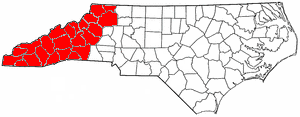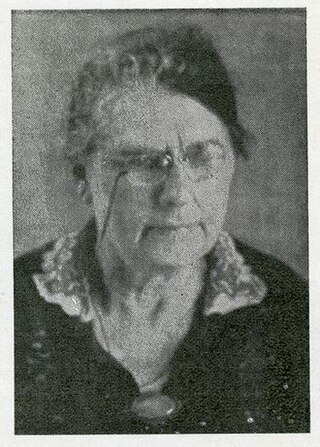Related Research Articles

Gatlinburg is a mountain resort city in Sevier County, Tennessee. It is located 39 miles (63 km) southeast of Knoxville and had a population of 3,944 at the 2010 Census and a U.S. Census population of 3,577 in 2020. It is a popular vacation resort, as it rests on the border of Great Smoky Mountains National Park along U.S. Route 441, which connects to Cherokee, North Carolina, on the southeast side of the national park. Prior to incorporation, the town was known as White Oak Flats, or just simply White Oak.

Appalachia is a socio-economic region located in the central and southern sections of the Appalachian Mountains of the Eastern United States. It stretches from the western Catskill Mountains in the east end of the Southern Tier of New York state west and south into Pennsylvania, continuing on through the Blue Ridge Mountains into northern Georgia, and through the Great Smoky Mountains from North Carolina into Tennessee and northern Alabama. In 2020, the region was home to an estimated 26.1 million people, of whom roughly 80% are white.

Pi Beta Phi (ΠΒΦ), often known simply as Pi Phi, is an international women's fraternity founded at Monmouth College, in Monmouth, Illinois on April 28, 1867 as I. C. Sorosis, the first national secret college society of women to be modeled after the men's Greek-letter fraternity.

Appalachian music is the music of the region of Appalachia in the Eastern United States. Traditional Appalachian music is derived from various influences, including the ballads, hymns and fiddle music of the British Isles, the African music and blues of early African Americans, and to a lesser extent the music of Continental Europe.
James Still was an American poet, novelist and folklorist. He lived most of his life in a log house along the Dead Mare Branch of Little Carr Creek, Knott County, Kentucky. He was best known for the novel River of Earth, which depicted the struggles of coal mining in eastern Kentucky.

Western North Carolina is the region of North Carolina which includes the Appalachian Mountains; it is often known geographically as the state's Mountain Region. It contains the highest mountains in the Eastern United States, with 125 peaks rising to over 5,000 feet in elevation. Mount Mitchell at 6,684 feet, is the highest peak of the Appalachian Mountains and mainland eastern North America. The population of the region, as measured by the 2010 U.S. Census, is 1,473,241, which is approximately 15% of North Carolina's total population.

Gurney Norman is an American writer documentarian, and professor.

Southern Highland Craft Guild is a guild craft organization that has partnered with the National Park Service for over seventy years. The Guild represents over 800 craftspeople in 293 counties of 9 southeastern states. It operates four retail craft shops and two annual craft expositions which represent the Guild members' work. These expositions occur in July and October and have taken place in the Appalachian mountain region since 1948.

The Sugarlands is a valley in the north-central Great Smoky Mountains, located in the Southeastern United States. Formerly home to a string of small Appalachian communities, the valley is now the location of the Great Smoky Mountains National Park headquarters and the Sugarlands Visitor Center. Lying just south of Gatlinburg, the Sugarlands is one of the park's most popular access points.

Appalachian studies is the area studies field concerned with the Appalachian region of the United States.

The Pine Mountain Settlement School is a historic cultural and educational institution in rural Harlan County, Kentucky. Founded in 1913 as a settlement school near Bledsoe, it now focuses on classes related to the culture of Appalachia and environmental education. It first operated as a boarding grade school for students of the rural region, then in 1930 shifted to operating as a boarding school for high school students. In the later 20th century, it was integrated into the Harlan County Public School System. Its campus is designated as a National Historic Landmark District, for its role as the first major effort to adapt urban settlement reform work into a rural setting.

Katherine Rebecca Pettit was an American educator and suffragist from Kentucky who contributed to the settlement school movement of the early 20th century.
Hindman Settlement School is a settlement school located in Hindman, Kentucky in Knott County. Established in 1902, it was the first rural settlement school in America.
Rebecca Caudill Ayars was an American writer of children's literature. More than twenty of her books were published. Tree of Freedom was a Newbery Honor Book in 1950. A Pocketful of Cricket, illustrated by Evaline Ness, was a Caldecott Honor Book.

Arrowmont School of Arts and Crafts is an Arts and Crafts center in the U.S. city of Gatlinburg, Tennessee. The oldest craft school in Tennessee, Arrowmont offers workshops in arts and crafts such as painting, woodworking, drawing, glass, photography, basket weaving, ceramics, fiber arts, book arts and metalworking. The School has an 11-month Artists-in-Residence program for early career artists. Arrowmont's campus contains the oldest buildings in Gatlinburg and comprises two historic districts listed on the National Register of Historic Places.

Kingdom Come Settlement School in Linefork, Letcher County, Kentucky, was a settlement school founded as a Methodist mission in 1924.
Stuart Robinson School was a settlement school in Blackey, Letcher County, Kentucky, established in 1913 as a Presbyterian mission. It closed in 1957, after graduating its last class in 1956.
Jim Wayne Miller was an American poet and educator who had a major influence on literature in the Appalachian region.
Charles Counts (1934–2000) was an American potter, designer, textile artist, quilter, teacher, writer, and activist. Counts worked to preserve the art forms of his native Appalachia, and later moved to Nigeria where he taught until his death.

Helen Dingman was an American academic and social worker who was one of the central figures in the Progressive and New Deal eras to bring social and economic reform to Appalachia. After teaching in Massachusetts for five years from 1912 to 1917, Dingman moved to Kentucky to establish the Smith Community Life School under the auspices of the United Presbyterian Church. Serving as principal and directing six other schools in Harlan County, Kentucky, she provided both education and social services to the community until 1922. After a two year placement as an assistant superintendent for the mission board in New York, she was hired as a teacher in the Sociology Department at Berea College. She taught social work courses and trained teachers for the rural schools in the region until 1952. In addition, she served as Executive Secretary of the Conference of Southern Mountain Workers, establishing the professional basis for social workers. The first comprehensive economic and social survey of the Southern Appalachias was spearheaded by Dingman.
References
- 1 2 Judy Flavell, Settlement Schools and the Culture of the Mountains, KET-TV website, accessed August 3, 2010
- 1 2 3 Mission and History Archived 2008-05-19 at the Wayback Machine , Hindman Settlement School website
- ↑ Arrowmont Archived 2007-10-10 at the Wayback Machine from the Pi Beta Phi web site
- 1 2 3 History Archived 2008-07-03 at the Wayback Machine , Pine Mountain Settlement School website
- 1 2 The Appalachian Settlement Schools, KET, Lexington, Kentucky
- 1 2 3 Jennifer Minton, The Current Roles of Settlement Schools, KET, Lexington, Kentucky
- 1 2 Josh Flory, Pi Beta Phi fraternity to sell Arrowmont land, Knoxville News Sentinel, August 16, 2008
- ↑ "A Representative List of Appalachian Settlement Schools". Kentucky Educational Television . 1995. Archived from the original on 2012-08-04. Retrieved September 21, 2020.
- ↑ "Settlement schools, settlement houses, mission schools, sponsored schools & early colleges in the Southern Appalachians and Social or Sponsored Organizations related to Settlement Schools in the Southern Appalachians". D.H. Ramsey Library, Special Collections, University of North Carolina Asheville. Archived from the original on 2012-07-14. Retrieved September 21, 2020.
(Source is no longer available at UNC Asheville.)
- 1 2 3 4 5 Kleber, John E. The Kentucky Encyclopedia. University Press of Kentucky. ISBN 978-0-8131-2883-2.
- ↑ Pearl Cashell Jackson, Pi Beta Phi Settlement School (University of Texas, 1927).
- ↑ Helen Wykle (October 28, 2008), "Riverside Christian Training School", Settlement Schools of the Southern Mountains, D.H. Ramsey Library, Special Collections, University of North Carolina Asheville (Note: this source is no longer at this repository)
- ↑ Helen Wykle (October 28, 2008), "Stuart Robinson School", Settlement Schools of the Southern Mountains, D.H. Ramsey Library, Special Collections, University of North Carolina Asheville, archived from the original on March 20, 2012 (Note: this source is no longer at this repository)
- ↑ Helen Wykle (October 11, 2008), "Sunset Gap Community Center", Settlement Schools of the Southern Mountains, D.H. Ramsey Library, Special Collections, University of North Carolina Asheville (Note: this source is no longer at this repository)